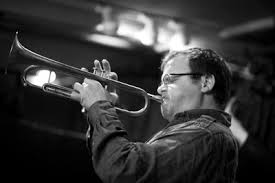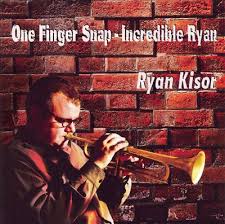Horror Show – Ryan Kisor
Not a particularly creepy song, but definitely a workout! The melody presents a real challenge for any instrument.
- Recording: Ryan Kisor - One Finger Snap - Incredible Ryan
- Recorded on: July 21, 2006
- Label: Video Arts Music (VACM 1294)
- Concert Key: No key center
- Vocal Range: , to
- Style: Swing (uptempo)
- Trumpet - Ryan Kisor
- Piano - Peter Zak
- Bass - John Webber
- Drums - Joe Strasser
0:00
0:00
Buy MP3
Video
- Description
- Historical Notes
- Solos
- Piano Corner
- Bass Corner
- Drum Corner
- Guitar Corner
- Inside & Beyond
- Minus You
If you don't have your technical chops together this will definitely be a "horror show" for you if you try to play it at Ryan's tempo. Just listen to our audio excerpt! Like many of Ryan's compositions, this one can also become a valuable technique etude to practice.
The quickly-moving chords under the melody in the A section are doubled in time value for the solo changes (the C section), with one exception: there are still two measures of Amaj7 after the F♯m7, instead of having it stretched into four measures. The six measures of A(♭2) and six measures of A♭(♭2) are kept for the solos; on the head, this is not obvious because the Latin feel (the B section) begins on the second measure of A(♭2).
The A(♭2) and A♭(♭2) chords are basically the root, flat 2nd, and 5th. The melody in the measure before B spells out a chord structure that Ryan uses in his solo, with a major 3rd and flat 6th. He often also uses the minor 3rd or sharp 2nd. Pianist Peter Zak often adds the flat 5th (D) in his voicings for A♭(♭2).
The quickly-moving chords under the melody in the A section are doubled in time value for the solo changes (the C section), with one exception: there are still two measures of Amaj7 after the F♯m7, instead of having it stretched into four measures. The six measures of A(♭2) and six measures of A♭(♭2) are kept for the solos; on the head, this is not obvious because the Latin feel (the B section) begins on the second measure of A(♭2).
The A(♭2) and A♭(♭2) chords are basically the root, flat 2nd, and 5th. The melody in the measure before B spells out a chord structure that Ryan uses in his solo, with a major 3rd and flat 6th. He often also uses the minor 3rd or sharp 2nd. Pianist Peter Zak often adds the flat 5th (D) in his voicings for A♭(♭2).
In 2000, Ryan started recording albums as a leader for the Video Arts label (Japan) with the album "Kisor," which contained no Ryan originals, but is a beautiful tribute album to Clifford Brown; he recorded Clifford's two jazz standards Daahoud and Sandu. Fortunately, most of his recordings for Japan are now available as downloads in the US. He followed this album in 2001 with "Kisor II." After a couple more Criss Cross recordings (later in 2001 and 2002) he returned to Video Arts to record "The Sidewinder" (2003), "Donna Lee" (2004), and "This Is Ryan" (2005,) which leads up to our recording in 2006. We will be getting into the history behind these other recordings as we bring you more of Ryan's originals.
Related Songs
Email Send Horror Show to a friend
Send this page to a friend via email. Add your name or email in the first field. In the second, add one or more email addresses, separated by a comma.

Ryan Kisor
born on April 12, 1973
Perhaps best known for his work with the Jazz at Lincoln Center Orchestra, Ryan Kisor is an accomplished trumpeter and one of the rising names on the jazz scene. Firmly rooted in the post-bop tradition, Ryan has obviously done a lot of listening to giants like Clifford Brown and Booker Little and Woody Shaw. Of course, he's also been influenced by contemporary mentors including Clark Terry and Wynton Marsalis, both masters of the art of great trumpet playing. Read more...
There was a problem.
...

